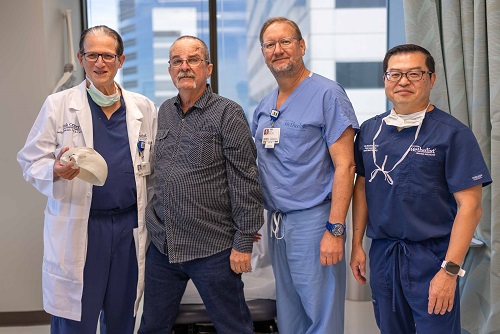For Gladys Tsao-Wu, MD, and Jennifer Chan, MD, reconstruction is as much about helping patients recover emotionally as it is about physical restoration. For over a decade, the two surgeons have been a team, helping breast cancer survivors in New Mexico.
Tag: Plastic And Reconstructive Surgery
Microneedling plus cupping may aid skin rejuvenation
A combination of emerging and alternative techniques – microneedling to induce collagen and cupping to increase tissue perfusion – may have a synergistic effect in producing skin rejuvenation, according to an experimental study in the June issue of Plastic and Reconstructive Surgery®, the official medical journal of the American Society of Plastic Surgeons (ASPS). The journal is published in the Lippincott portfolio by Wolters Kluwer.
Does body contouring increase long-term weight loss after bariatric surgery? New findings
For patients with massive weight loss after bariatric surgery, subsequent body contouring to remove excess skin is not itself associated with long-term weight loss, reports a study in the June issue of Plastic and Reconstructive Surgery®, the official medical journal of the American Society of Plastic Surgeons (ASPS). The journal is published in the Lippincott portfolio by Wolters Kluwer.
Routine antibiotics don’t improve outcomes of post-mastectomy breast reconstruction
For breast cancer patients undergoing breast reconstruction after mastectomy, avoiding postoperative oral antibiotics does not reduce the risk of infections, reports a study in the May issue of Plastic and Reconstructive Surgery®, the official medical journal of the American Society of Plastic Surgeons (ASPS). The journal is published in the Lippincott portfolio by Wolters Kluwer.
LBBC Spring Patient Experience Newsletter: Equity and Financial Toxicity
While Keneene Lewis of Atlanta was undergoing chemotherapy in 2019, bill collectors were calling her home. Today, she encourages those she meets to speak up and advocate for themselves. Plus, new FDA guidance on the risk factors of dense breasts, and the petition demanding equitable access to DIEP flap breast reconstruction.
Social and medical factors may explain cognitive impact of delayed craniosynostosis surgery
For infants with the skull deformity craniosynostosis, head reshaping surgery after age 12 months has long been linked to impaired cognitive and language development. Now a new study suggests that the difference in developmental outcomes may reflect a range of other patient characteristics and clinical factors affecting age at surgery, reports the April issue of Plastic and Reconstructive Surgery®, the official medical journal of the American Society of Plastic Surgeons (ASPS). The journal is published in the Lippincott portfolio by Wolters Kluwer.
Higher body mass index linked to longer healing time after breast reduction surgery
For patients undergoing breast reduction surgery (reduction mammaplasty), higher body mass index (BMI) is a risk factor for delayed wound healing, reports a study in the April issue of Plastic and Reconstructive Surgery®, the official medical journal of the American Society of Plastic Surgeons (ASPS). The journal is published in the Lippincott portfolio by Wolters Kluwer.

Surgeons remove grapefruit-sized tumor from man’s brain; implant 3D computer generated prosthetic skull piece
Patient Chris DeHart had a massive meningioma that required 9 surgeries and 3 surgical specialties to remove. He relied on a Houston Methodist ‘dream team’ of surgeons to solve his case.
Gender-related differences in coding contribute to lower incomes for women plastic surgeons
Why do female plastic surgeons earn less than their male colleagues? Differences in billing and coding for procedures performed may partially explain this income gap, according to a study in the November issue of Plastic and Reconstructive Surgery®, the official medical journal of the American Society of Plastic Surgeons (ASPS). The journal is published in the Lippincott portfolio by Wolters Kluwer.
Few patients undergo recommended MRI screening after silicone implant breast surgery
Only six percent of women with silicone breast implants followed the previous US Food and Drug Administration (FDA) recommendation for regular magnetic resonance imaging (MRI) screening, suggests a study in the August issue of Plastic and Reconstructive Surgery®, the official medical journal of the American Society of Plastic Surgeons (ASPS).
What are the most attractive lips? More attention doesn’t mean most beautiful
At a time when social media and celebrity icons are driving increased demand for fuller, “pouty” lips, a natural-looking and harmonious appearance of the lips is perceived as most attractive, reports a study in the August issue of Plastic and Reconstructive Surgery®, the official medical journal of the American Society of Plastic Surgeons (ASPS).
Did your plastic surgeon really turn back the clock? Artificial intelligence may be able to quantify how young you actually look after facelift surgery
For most patients, the reasons for having a facelift are simple: to “turn back the clock” for a younger and more attractive appearance. Even during the pandemic year 2020, more than 234,000 patients underwent facelift surgery, according to American Society of Plastic Surgeons (ASPS) statistics.
What We Learned After 5,000 Non-Surgical Rhinoplasties
As patients continue to seek non-invasive treatments across the cosmetic spectrum, “liquid rhinoplasty” is emerging as the non-surgical alternative to the traditional nose job. Using dermal fillers to change the appearance of the nose, non-surgical rhinoplasty is gaining in popularity due to its relatively low cost, convenience, and short recovery time.
Omega-3 Fatty Acids May Prevent Breast Implant Complications, Like Capsular Contracture
For women receiving breast implants during reconstructive or cosmetic breast surgery, scarring around the implant – called capsular contracture – is a common, costly, and painful complication. The anti-inflammatory effects of omega-3 fatty acids, found in fish oil, might help to avoid abnormal capsule formation suggests an experimental study in the March issue of Plastic and Reconstructive Surgery®, the official medical journal of the American Society of Plastic Surgeons (ASPS).